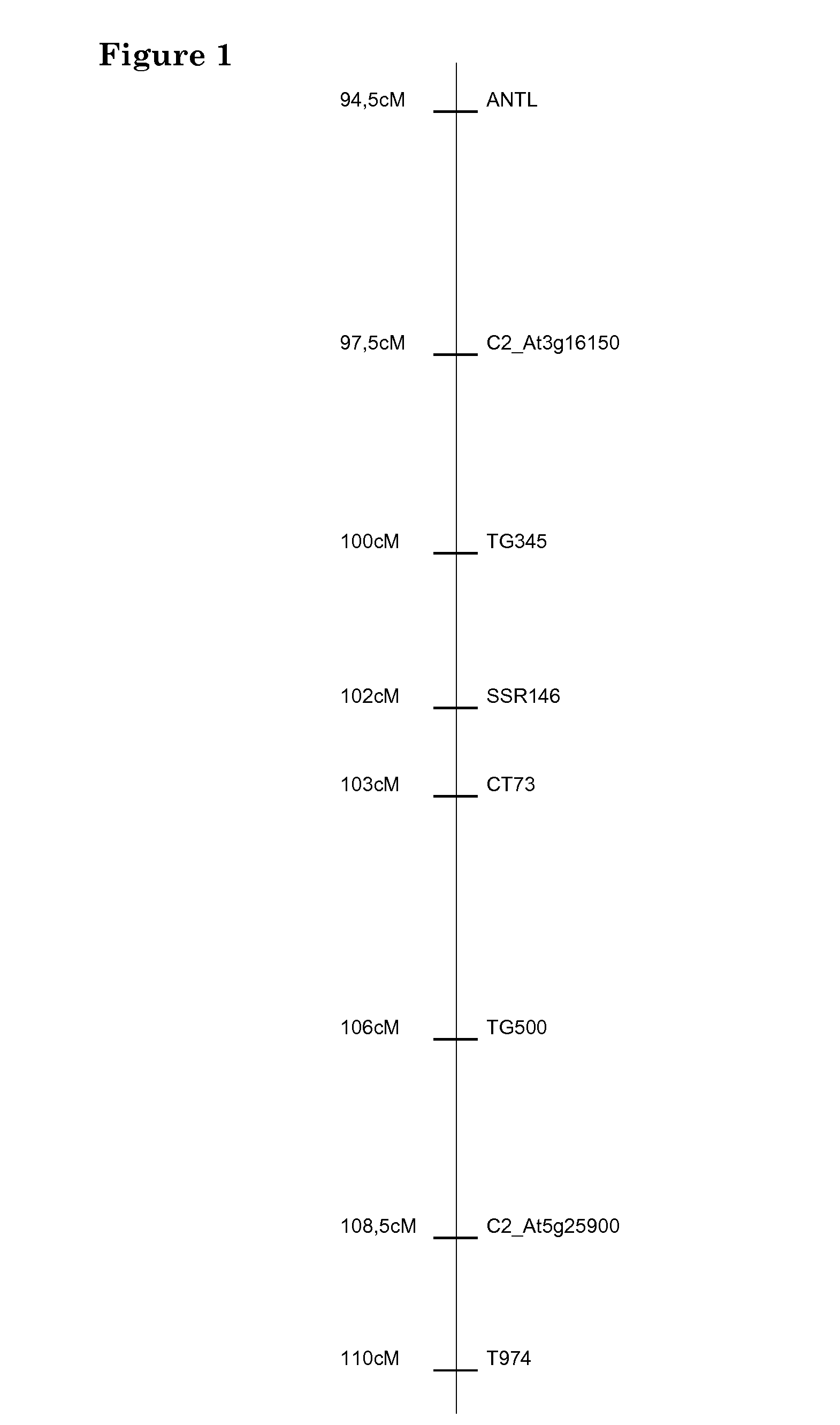Plants having tomato torrado virus resistance
a technology of tomato torrado virus and plant, which is applied in the field of plants having tomato torrado virus resistance, can solve the problems of disease symptoms that cannot be detected in these plants, viral particles, or viral rna cannot be detected, so as to improve the efficiency of breeding and improve the time-to-market
- Summary
- Abstract
- Description
- Claims
- Application Information
AI Technical Summary
Benefits of technology
Problems solved by technology
Method used
Image
Examples
example
Example 1
Identification of Markers Linked to the ToTV Resistance Gene in Tomato
[0111]The aim of this experiment was to identify AFLP markers linked to ToTV resistance in tomato, by use of a Bulk Segregant Analysis (BSA; Michelmore, R. W., I. Paran and R. V. Kesseli, 1991. Proc. Natl. Acad. Sci. USA, 88: 9828-9832).
[0112]ToTV resistance was found to be a monogenic recessively inherited trait. The analysis was carried out on 150 plants of a F2 tomato cultivar cross of which the F3 plants were phenotyped. For determination of a reliable phenotype, phenotyping on F3 plants was repeated several times for a subset of F2 plants. Based on the results obtained by repeated phenotyping, 18 individuals were indicated as being reliable resistant and nine plants were indicated as being reliable susceptible. These plants were used for the BSA. The phenotypic information from these individuals is listed in table 1.
Marker Identification and Verification
Marker Nomenclature
[0113]Codes by which the AFL...
example 2
Use of Marker C2_At5g25900 and Restriction Enzyme Mse I to Detect the Recessive Resistance for ToTV
Sample:
[0145]A DNA sample of tomato tissue from each plant of a test population was prepared by using standard preparation techniques (microprep, e.g. as referred to in Fulton T M, Chunwongse J, and Tanksley S D. (1995) Microprep Protocol for Extraction of DNA from Tomato and other Herbaceous Plants. Plant Molecular Biology Reporter 13 (3): 207-209.).
[0146]The PCR Chemicals Were the Following:[0147]dNTP's (213mM Stock) (Amersham Bioscience)[0148]SuperTherm polymerase (Integro)[0149]Forward primer (10_ng / μl) 5′ TGC TAA TTG GGC TGA AAC TTA TGG (SEQ ID NO:7)[0150]Reverse primer (1013 ng / μl) 5′ TGT TAG CTT TCT AGT TGA GAT GGA TG (SEQ ID NO:8)[0151]10×_PCR buffer 2513 mM MgC12 [0152]Loading buffer[0153]Ethidium_bromide (10mg / ml)[0154]1× TE[0155]0,5× TBE (Duchefa)[0156]Restriction enzyme Mse I (New England Biolabs)
The PCR Mixture Consisted of (Per Sample):
[0157]2.0 μl 10× PCR buffer (25 mM M...
PUM
| Property | Measurement | Unit |
|---|---|---|
| pH | aaaaa | aaaaa |
| speeds | aaaaa | aaaaa |
| resistance | aaaaa | aaaaa |
Abstract
Description
Claims
Application Information
 Login to View More
Login to View More - R&D
- Intellectual Property
- Life Sciences
- Materials
- Tech Scout
- Unparalleled Data Quality
- Higher Quality Content
- 60% Fewer Hallucinations
Browse by: Latest US Patents, China's latest patents, Technical Efficacy Thesaurus, Application Domain, Technology Topic, Popular Technical Reports.
© 2025 PatSnap. All rights reserved.Legal|Privacy policy|Modern Slavery Act Transparency Statement|Sitemap|About US| Contact US: help@patsnap.com


